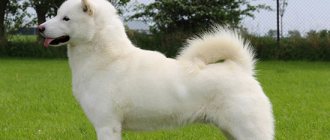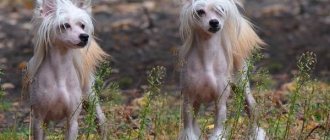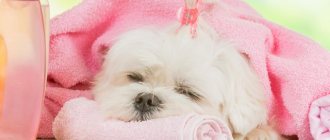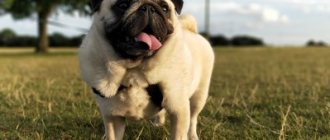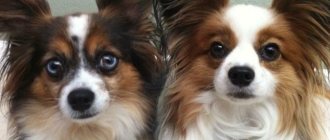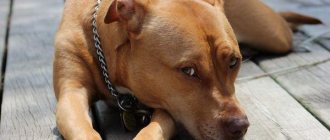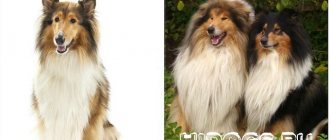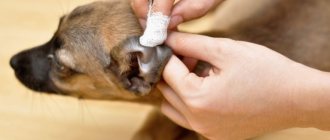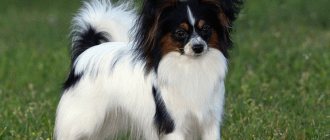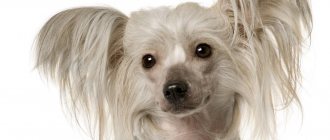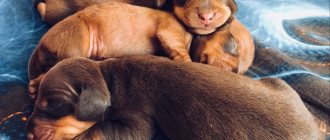Wool can tell us about a dog’s health: dull, tousled, brittle hair can indicate the onset of various diseases, including dermatological ones. Therefore, proper care is not only about appearance, but also about health.
There are six types of wool:
- Long (collie, shih tzu, Yorkshire terrier, golden retriever).
- Medium (Labrador, Central Asian Shepherd, German Shepherd).
- Smooth (dachshund, basenji, bulldog).
- Tough (West Highland White Terrier, Airedale Terrier, Giant Schnauzer).
- Curly (Bichon Frize, Poodle, Kerry Blue Terrier, Bedlington Terrier).
- Exotic wool (puli, commander, Mexican hairless).
Caring for your dog's long hair
Long hair looks very beautiful, but it requires serious care. The main rule is regular brushing. All basic care is based on it, because with insufficient combing, tangles quickly form. There are many tools available for combing this type of wool, but it is best to opt for a wide-tooth comb. It is better if it is made from natural materials. The area around the eyes, around the anus, and between the paw pads also needs special care. This wool needs to be cut. It is worth bathing a long-haired dog when it gets dirty. For washing, choose products that are suitable for your coat type. Professional groomers can help you with this choice.
Care depending on coat type
Based on its length, they are distinguished:
1. Dogs with long hair . It is typical for collies, Yorkshire terriers, and Afghan hounds. Requires care and constant brushing. Owners of such dogs need to have brushing products in their arsenal, preferably made from natural material.
Collies have a length of six
2. Having medium length wool . They make up the most trouble-free part of the dog tribe. These include German Shepherds, East European Shepherds, Retrievers, Labradors, most Laika breeds, and Central Asian Shepherds. It is necessary to comb out the undercoat, especially during the molting period.
The German Shepherd has a medium length coat
3. Smooth-haired dogs . Their coat is short and has a small undercoat. Typical for breeds such as Rottweilers, Dachshunds, Boxers, and American Staffordshire Terriers. Requires regular brushing with a rubber or soft clothing brush. Frequent bathing is contraindicated for a pet with smooth hair; this is usually done several times a year.
The Rottweiler is a smooth-haired dog
4. Wire-haired dogs . Many terriers and schnauzers require brushing, trimming and clipping. These include: Fox Terriers, Airedale Terriers, Giant Schnauzers and others. Without proper care, their fur becomes matted, turning into a thin, hard shell. It is best to entrust your first haircuts to specialists, from whom you can learn.
Example of a Wire Fox Terrier
5. Having curly hair . The appearance of the Bedlington Terrier would be very different from the original if it were not for regular haircuts and combing of the dog's coat. The last event should be carried out at least twice a week. Otherwise, the resulting tangles will only have to be cut off. Trips to the groomer will become part of the mandatory program for caring for such coat. You will need to bathe your ward two or three times a month, since the dirt simply sticks to it.
Close-up of a Bedlington Terrier's curly coat
6. With exotic wool . These include dogs that do not fall into any of the above categories. It is difficult to determine the type of fur of a Chinese Crested if it is practically absent. The situation with the commander is different - his fur looks like many woolen cords. When buying such a dog, you need to consult with experienced owners.
The Chinese Crested Dog is predominantly hairless
Caring for exotic fur
Owners of exotic wool cannot be classified into any subgroup. For example, the Mexican Hairless Dog is completely hairless, while the Komondor has hair that curls into strands (dreadlocks). They are extremely specific in their care. In order to learn how to care for such dogs, you need to contact a specialist who will train you. It is necessary to learn so as not to harm your pet.
A well-groomed, clean dog with shiny fur pleases the eye not only of the owner, but also of those around him.
Procedures and tools
The main things in home grooming are combing, bathing and cutting dogs. Depending on the type of fur and breed of the pet, these activities are carried out with different frequencies and using different tools.
To care for your dog you will need:
- Suitable brushes and combs . There are a great variety of them and there is no universal one that suits everyone. Some people need a soft brush that pleasantly massages the skin, while others need to comb it with a slicker brush or a furminator.
- A trimmer and scissors will definitely come in handy for the owners of most animals, since most breeds need to trim certain areas of the face, under the tail and between the toes.
- Personal dog towel to be used after bathing. To prevent the dog from getting sick and his hair from becoming too tangled, after water treatments he must be very thoroughly wiped and dried. If the animal is brave enough, you can even use a hairdryer for this.
- Special shampoos and conditioners suitable for the type.
READ ALSO: Is it possible to cut a dog’s hair with a human clipper?
How to care for your fur
Caring for wool products Felt items can and should be washed. But wool is a delicate material. Caring for such work has its own characteristics. It is enough to follow a few simple rules so that the product serves for a long time and does not lose its appearance.
What not to do when caring for a wool product: Wash in a washing machine. Bleach. Dry clean. Rinse in water that is too hot or too cold. Squeeze in a centrifuge. Dry in direct sunlight or in a stream of hot air (battery). Hand washing is the main type of care for felted and felt products. In a washing machine, even in the “wool” wash cycle, the product may continue to pill, and will not only lose its shape, but may also significantly decrease in size. It is also not recommended to rub the product when washing to avoid deformation. It is enough to soak the product in a solution with a product (soap, shampoo) for 1-2 hours, and then rinse thoroughly. The water temperature for washing and rinsing should be 35-40 C, otherwise the product may shrink. Also, for washing, some recommend using detergents containing lanolin (lanolin is wool wax, an animal wax obtained by boiling sheep's wool). This is a natural fat that envelops every hair. Gives it flexibility, softness (removes prickliness), shine and purity. Lanolin repels dirt, helping wool to “clean itself.” This is why woolen items do not require frequent washing. Regular powders often contain bleach, so their use is not recommended - a wool product may lose its original color. Woolen items are squeezed out in a lump, squeezing between the palms. The adhesion of wool fibers occurs due to the scales covering each wool. These scales open up in a wet alkaline environment (soapy water), like the “split” hair in the Pantene commercial. When the felt is dry, the scales are closed and the adhesion between the fibers is strong. When the felt gets wet, the grip weakens and the fabric is easy to stretch. When twisting, individual parts of the canvas are stretched and it loses its shape. After washing, felted products can be ironed with steam at a temperature of 130-160°C (this temperature is indicated by two dots on the iron). It is better to iron the felt immediately after spinning - wet. You don't have to iron it at all. Whoever likes it. After the above procedures, the product must be straightened and dried on a flat, horizontal surface, although this is not necessary. You can wrap the product in a towel to remove moisture. Give bulky items such as slippers, bags, hats their shape by placing a folded towel inside the item. Afterwards, straighten and dry in the open air. You can dry it on a slightly warm radiator, but under no circumstances should it be hot or in the sun, as things may shrink. Felt products are recommended to be stored next to a lavender sachet or other moth repellent. Natural wool loves fresh air - in the summer, when a felt product is put away for storage, occasionally take it out and ventilate it.
Arch-comb
For sale on the Internet you can find such a device as an arch for combing wool. This is something like a curved brush that is placed on the floor on a special stand. An animal, eager to scratch itself, begins to rub against this arch, thereby putting itself in order.
But whether your cat wants to use such a device is purely individual. To attract the animal to the unit, it is recommended to use catnip.
However, in any case, the arch is only an additional, and not the main tool when combing cats. She cannot comb it properly.
Combing smooth wool - what you need to know?
Caring for dogs with such coats is simple and not labor-intensive. Basically, pet owners will need to regularly brush the coat with a special brush or glove, remove dead hairs and massage. This will help preserve the beauty and shine of the covers. To do this, you need to use combs and brushes with bristles of medium hardness, but not too soft. Such instruments are not capable of harming the epidermis, but are tough enough to remove contaminants in several steps.
Before you begin cleansing the coat, you should perform a massage. You can simply stroke your four-legged pet against the growth of the fur for several minutes, after which you can begin combing it in the same direction. Combing is done starting from the neck and back of the animal, then the stomach, chest area, limbs and tail are processed. When combing show dogs, it is recommended to use pieces of velvet, suede or flannel. Such fabrics contribute to high-quality polishing of the cover.
After completing the procedure, you should take a clean comb with non-sharp teeth and walk through the coat in the direction of hair growth. Such actions are massage, which helps improve blood circulation and muscle tone. Combs and brushes must be stored correctly; for this you need to choose a special place. They are also cleaned using warm water, soap, and disinfectants.
It is worth noting that such hygiene procedures bring pleasure to four-legged pets. In spring and autumn, seasonal molting occurs. To make you feel better and quickly remove dead hair, you need to comb the coat more often, for example, at least once a day, and preferably twice. This minimizes its appearance on furniture, clothing, and carpeting.
During the combing process, veterinarians recommend examining the skin. The presence of skin parasites, abrasions, scratches, seals, and bald patches may be a cause for concern. Minor non-dangerous defects in the epidermis can be treated independently, but if you lack experience and the necessary knowledge, immediately contact a veterinary clinic.
Which breeds have less hair?
Taking into account the laboriousness of caring for the fur of four-legged friends, many potential owners choose breeds that require minimal costs. Low-shedding breeds include such popular breeds as the Yorkshire terrier, poodles, schnauzers, and Chinese Crested. Less common breeds that shed less frequently include the Brussels Griffon, Tibetan Terrier, and Portuguese Water Dog.
We recommend reading about salmonellosis in dogs. You will learn about the sources of salmonella infection, symptoms of the disease, necessary diagnosis and treatment, and prevention. And here is more information about cholecystitis in dogs.
Dog grooming includes brushing, bathing and trimming. The features of a particular procedure and the choice of instrument are dictated primarily by the structure of the hair of a particular breed of animal.
Useful video
To learn how to properly care for your dog's fur, watch this video:
Similar articles
- A convenient device for grooming...
The use of this device greatly facilitates grooming, makes the procedure effective and enjoyable as... Devices in the Small and Medium formats are optimal for representatives of the cat family and medium-sized dog breeds. Read more - Scabies mite in cats, dogs and other fur-bearing animals
The fur at the bottom of the ears sticks together. The ear canal becomes clogged with crusts of dried exudate... Puppies from nursing mothers get sick. Large dogs get sick more often... when they come into contact with infected animals through grooming items: leashes... Read more
- Bathing a dog: how to wash it at home...
All Internal diseases in dogs Infections and parasites Care and education. ... If a dog has hard hair, then water treatments will not be needed as often as those with soft hair. Read more
- Otitis in a dog (purulent, allergic, fungal...)
Violation of hygiene and pet care rules. ... The risk group includes dog breeds characterized by increased thickness of hair in the ear area: lapdogs, giant schnauzers, setters. Read more
Selection of soap accessories
Specialized pet stores provide a wide range of detergents for caring for the fur of four-legged friends. When choosing bath and soap accessories, the owner should take into account factors such as the length and color of the coat, its condition, and whether the pet is allergic to certain components of the shampoo.
First of all, you should pay attention to what type of coat the shampoo is intended for. For example, for long-haired breeds, special products have been developed to make further combing easier.
When choosing a shampoo, you need to pay attention to the composition. The less aromatic and coloring substances it contains, the less likely it is that your pet will develop an allergic reaction.
Shampoos and conditioners for dogs
Additional ingredients in the form of medicinal herbs and other beneficial components will be required if the owner pursues certain goals. For example, if your pet has dry skin, then shampoo with oat extract will help, and to achieve an antiseptic effect, you should pay attention to the presence of tea tree oil in the composition.
For long-haired breeds, conditioners can be used. They make hair easier to comb and prevent the formation of tangles. The use of conditioners makes the coat shiny and elastic, and helps repel dirt.
To learn how to choose shampoo for your dog, watch this video:
